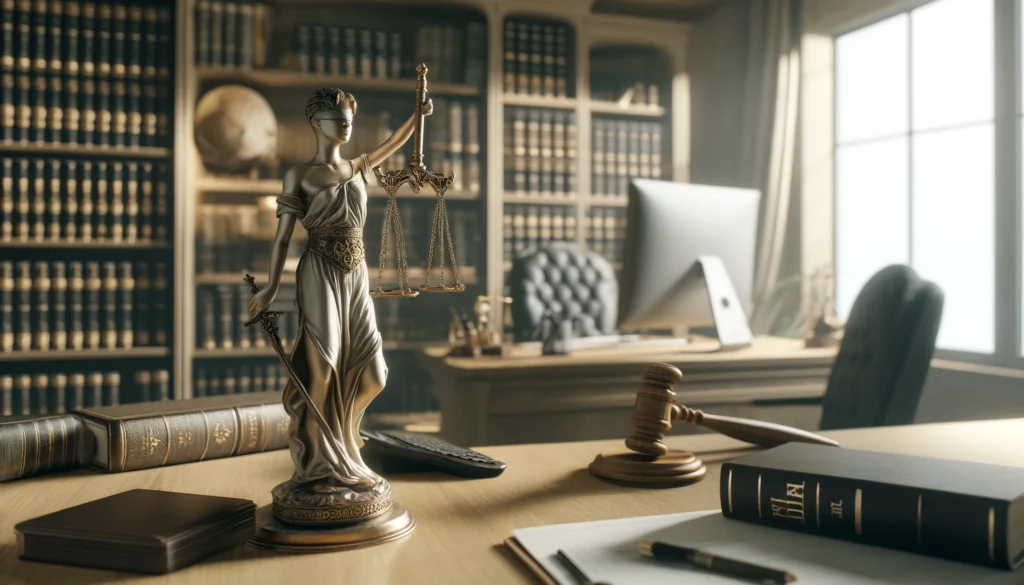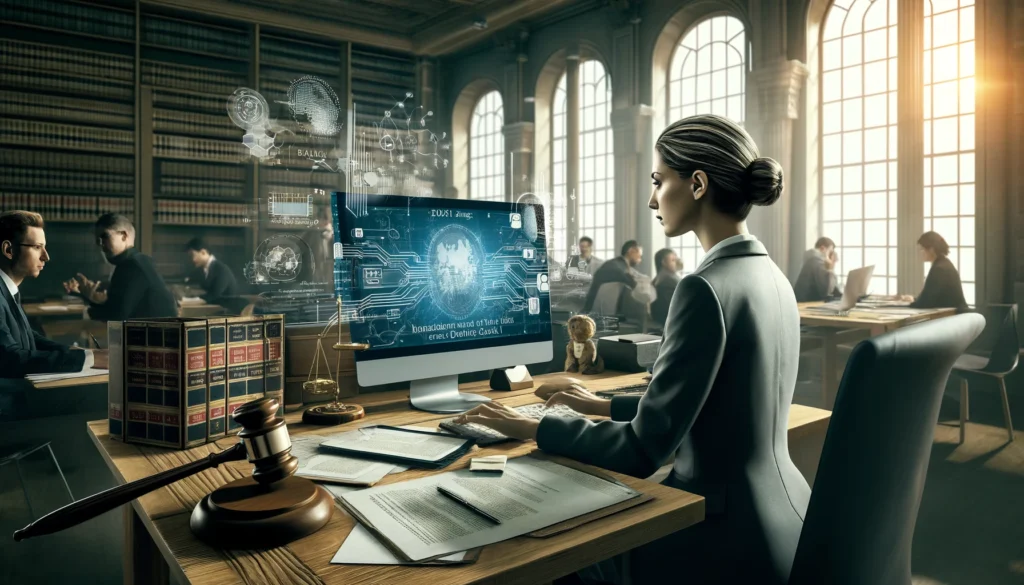
Introduction
In the ever-evolving landscape of criminal litigation, the organization of discovery materials stands as a formidable pillar in the construction of a robust defense or prosecution. As cases become increasingly complex and the volume of discovery materials burgeons, the task of sifting through, categorizing, and leveraging this information becomes a Herculean endeavor. This challenge, however, is not insurmountable. The advent of Large Language Models (LLMs) such as ChatGPT has ushered in a transformative era for legal professionals, particularly paralegals, who are at the forefront of managing these critical materials.
The integration of ChatGPT and similar technologies into the legal workflow represents a leap forward in efficiency and accuracy, providing a beacon of hope for overwhelmed paralegals. These advanced tools are not just about handling the sheer volume of data; they offer a nuanced approach to organizing discovery materials, ensuring that every piece of evidence is exactly where it needs to be, at the precise moment it’s required. By harnessing the capabilities of LLMs, paralegals can navigate the vast oceans of discovery documents with newfound agility, turning what was once a daunting task into a streamlined process.
As we delve into the mechanics of this transformation, it’s essential to understand the pivotal role of prompting techniques in maximizing the potential of ChatGPT within the legal domain. Through strategic prompting, paralegals can unlock powerful functionalities, from auto-categorizing emails and documents to summarizing depositions and identifying key pieces of evidence. This article aims to guide paralegals through the intricacies of utilizing ChatGPT for the efficient organization of discovery materials, marking a significant stride towards mastering the digital tools that redefine the boundaries of legal practice.
Understanding Discovery Materials
The discovery phase in criminal litigation is a critical period where both the prosecution and defense gather and exchange information pertinent to the case. This stage is foundational, setting the groundwork for trial preparation. It encompasses a wide array of materials including witness statements, police reports, forensic evidence, digital data, and more. Each piece, whether pointing towards innocence or guilt, holds potential sway over the case’s outcome. The meticulous organization of these materials is not merely administrative; it is a strategic endeavor that can illuminate paths to victory or reveal pitfalls to avoid.
Paralegals, entrusted with the management of discovery materials, face a formidable task. The digitization of communication and the proliferation of electronic evidence have exponentially increased the volume of discovery. Managing this deluge, ensuring no critical piece of evidence is overlooked, and maintaining ready access to key documents under tight deadlines is a balancing act that requires precision, strategic foresight, and an intimate understanding of the case’s nuances.
The challenges are manifold. Discovery materials are often voluminous and disparate, spanning various formats and sources. The process of sifting through emails, text messages, financial records, and other digital footprints is time-consuming and fraught with the risk of overlooking crucial information. Moreover, the legal obligations to provide timely and complete discovery submissions add a layer of complexity, demanding not only organization but also a thorough understanding of legal standards and requirements.
In this intricate dance of legal obligations and strategic management, the role of technology, particularly LLMs like ChatGPT, becomes pivotal. These advanced tools offer paralegals the means to transcend traditional limitations, facilitating a more efficient, accurate, and strategic organization of discovery materials. As we explore the application of these technologies, it becomes clear that their integration into legal workflows is not just advantageous but essential for navigating the complexities of modern criminal litigation.
The Power of LLMs in Legal Work
In the realm of legal practice, where the written word is both sword and shield, Large Language Models (LLMs) like ChatGPT represent a formidable ally. These AI-driven tools have revolutionized the way legal professionals approach tasks that require not just a deep understanding of legal concepts, but also the ability to manipulate and organize vast amounts of textual data swiftly. LLMs excel in processing, summarizing, and generating text-based content, capabilities that are particularly valuable in the legal sector.
The application of LLMs extends beyond mere efficiency in document management. They offer a nuanced understanding of language, capable of parsing complex legal jargon and extracting relevant information from a sea of data. This ability is invaluable in legal work, where the precise interpretation of texts can influence case outcomes. Furthermore, LLMs can be trained to adhere to jurisdictional nuances, ensuring their assistance remains relevant and accurate across different legal landscapes.
For paralegals, the introduction of LLMs into their workflow doesn’t just signify an upgrade in efficiency; it heralds a shift towards a more strategic role in litigation support. By leveraging these advanced tools, paralegals can focus on higher-order tasks—such as strategic analysis and case preparation—while relying on LLMs to handle the labor-intensive process of organizing discovery materials. This synergy between human expertise and AI capabilities enhances the legal team’s overall effectiveness, offering a competitive edge in the increasingly complex arena of criminal litigation.
Getting Started with ChatGPT for Discovery Organization
Integrating ChatGPT into the organization of discovery materials marks a pivotal step toward leveraging AI in legal workflows. For paralegals navigating the vast expanses of discovery documents, ChatGPT emerges as an essential ally, equipped to streamline and enhance the document management process. Here’s how to commence this integration effectively:
- Understanding ChatGPT’s Capabilities: Begin with a grasp of what ChatGPT can do, particularly its ability to understand and generate complex language. This understanding is fundamental to leveraging its potential in legal contexts.
- Mastering Prompt Crafting:
- Clarity and Specificity: Craft prompts that are clear and specific. For instance, ask ChatGPT to “Summarize key points from the deposition of [Witness Name] regarding [Specific Event].”
- Task-Focused: Design prompts for categorizing documents, summarizing lengthy texts, or extracting critical information, directing ChatGPT to focus on precise tasks.
- Recognizing Limitations and Strengths:
- ChatGPT can process large volumes of text efficiently but always review its outputs for accuracy and relevance to the case.
- Understand that while ChatGPT is a powerful tool, it functions best under the guidance of human insight and verification.
- Incremental Integration:
- Start with simpler tasks to familiarize yourself with ChatGPT’s functionality.
- Gradually progress to more complex document management tasks as confidence in crafting effective prompts grows.
This structured approach not only facilitates the practical application of ChatGPT in legal document management but also ensures that its integration into legal workflows is both seamless and effective, enhancing the efficiency of discovery material organization.
Advanced Prompting Techniques for Discovery Material Organization
Leveraging ChatGPT for the organization of discovery materials in criminal cases necessitates a deep dive into advanced prompting techniques. These strategies not only refine the efficiency of managing vast data sets but also enhance the precision with which this AI tool can assist legal professionals. Below, we break down these techniques into structured strategies for optimal clarity and application:
Strategic Layering of Prompts:
- Incremental Detailing: Start with a broad prompt to categorize documents at a high level, then use subsequent, more detailed prompts for deeper analysis.
- Sequential Processing: Organize tasks in a sequence, moving from general to specific, allowing ChatGPT to gradually refine the organization and analysis of discovery materials.
Utilizing Conditional Logic in Prompts:
- If-Then Structures: Incorporate conditional logic to handle documents of varying relevance and type, e.g., “If a document pertains to [specific evidence], then categorize it under [specific category].”
- Outcome-Based Directions: Guide ChatGPT to make decisions based on the content it encounters, enhancing the relevancy of the categorization process.
Leveraging Metadata for Document Organization:
- Metadata Utilization: Direct ChatGPT to consider document metadata (such as date, author, or source) for organizing materials, improving the chronological or thematic sorting of evidence.
- Prompt for Metadata Analysis: Ask ChatGPT to analyze and summarize the metadata to identify patterns or discrepancies within the discovery materials.
Custom Tags and Summarization:
- Tagging System Implementation: Develop a system of custom tags for different types of evidence and case themes, instructing ChatGPT to apply these tags to relevant documents.
- Summarization with Tags: After tagging, prompt ChatGPT to generate summaries of documents based on tags, facilitating quick access to themed evidence clusters.
Cross-Referencing and Verification:
- Prompt for Cross-Referencing: Instruct ChatGPT to cross-reference statements or evidence across multiple documents, identifying corroborating or conflicting information.
- Verification Prompts: Use prompts that ask ChatGPT to verify the consistency of information within the organized documents, ensuring reliability in the evidence compilation.
Feedback Loop for Continuous Improvement:
- Iterative Feedback: Provide feedback on ChatGPT’s output to refine the accuracy and relevance of document organization over time.
- Adjustment Prompts: Use the insights gained from feedback to adjust and improve prompt structures for future tasks, enhancing the AI’s performance.
Customizable Prompt Templates for Different Discovery Tasks
To further streamline the organization of discovery materials using ChatGPT, developing a set of customizable prompt templates can be invaluable. These templates serve as adaptable blueprints for a wide range of discovery-related tasks, enabling paralegals to efficiently direct the AI in processing and organizing legal documents. Below are structured templates designed for various discovery tasks, ensuring ease of reading and application in line with the advanced prompting techniques previously discussed.
Template 1: Document Categorization
Purpose: To categorize discovery documents based on content, type, or relevance
Template:
Categorize the following document(s) into [List of Categories] based on [Type/Content/Relevance]. Apply the tag '[Custom Tag]' to documents that specifically relate to [Specific Criteria].Template 2: Summarization of Key Information
Purpose: To extract and summarize key information from voluminous documents.
Template:
Summarize the key information from the following document(s), focusing on [Specific Aspect, e.g., Witness Statements, Evidence Details]. Highlight any references to [Specific Individuals/Events/Evidence].Template 3: Chronological Organization
Purpose: To organize documents or evidence in chronological order.
Template:
Organize the following list of documents in chronological order based on their [Creation Date/Event Date]. Provide a brief summary of each document's key events or information in chronological sequence.Template 4: Identifying Contradictions or Corroborations
Purpose: To identify contradictions or corroborations in witness statements or evidence.
Template:
Review the following documents for any contradictions or corroborations related to [Specific Event/Statement]. Summarize instances of contradictions and corroborations, referencing the relevant documents.Template 5: Metadata Analysis
Purpose: To analyze and organize documents based on metadata.
Template:
Analyze the metadata of the provided documents, identifying patterns or anomalies in [Authorship, Date, Source]. Organize the documents based on these metadata insights, explaining the rationale for the organization.Template 6: Legal Precedent Linkage
Purpose: To link case documents to relevant legal precedents.
Template:
Identify connections between the provided case documents and relevant legal precedents pertaining to [Specific Legal Issue]. List the precedents and describe how each is related to the case documents.Practical Tips for Maximizing Efficiency with LLMs
To harness the full potential of LLMs like ChatGPT in organizing discovery materials, here are practical tips structured to enhance efficiency and ensure seamless integration into legal workflows:
- Prioritize Clear Objectives: Before prompting, define the specific goal you aim to achieve with ChatGPT. Clarity in your objectives ensures more targeted and useful responses.
- Use Structured Prompts: Build prompts with a clear structure, including specific actions and desired outcomes. This approach minimizes ambiguity and guides ChatGPT to provide the most relevant information.
- Review and Refine: Regularly review ChatGPT’s outputs for accuracy and relevance. Use these insights to refine future prompts, enhancing the precision of responses over time.
- Iterate and Experiment: Don’t hesitate to iterate on prompts or experiment with different phrasings. Discovering the most effective prompt structure for your needs can significantly boost efficiency.
- Leverage Custom Templates: Develop and utilize customizable prompt templates for recurring tasks. This strategy saves time and standardizes the quality of outputs across different cases.
- Incorporate Feedback Loops: Implement a feedback loop where the results from ChatGPT are evaluated and used to improve subsequent prompts, ensuring continuous optimization of the process.
Integrating ChatGPT Outputs into Legal Workflows
Successfully integrating ChatGPT outputs into legal workflows requires a systematic approach that ensures these outputs are utilized effectively and enhance the legal team’s productivity. Here are concise steps for seamless integration:
- Verification Step: Always include a step for verifying the accuracy of ChatGPT’s outputs against the original documents to ensure legal standards are met.
- Incorporation into Case Management Systems: Seamlessly integrate ChatGPT’s organized documents and summaries into your existing case management systems for easy access and reference by the entire legal team.
- Regular Updates: Keep the document organization and summaries updated with the latest information by scheduling regular sessions with ChatGPT for updates and revisions.
- Collaborative Review: Facilitate collaborative reviews of ChatGPT’s outputs within the legal team to ensure that all insights and organized materials are leveraged effectively in case strategy and preparation.
Conclusion
The integration of Large Language Models like ChatGPT into the organization of discovery materials represents a significant advancement in legal technology, offering paralegals and legal professionals unprecedented support in managing the complexities of criminal cases. By employing strategic prompting techniques, leveraging customizable prompt templates, and following practical tips for efficiency, legal teams can dramatically streamline their discovery processes. As we move forward, the continued refinement and adaptation of these approaches will not only enhance legal workflows but also contribute to more informed, efficient, and effective legal practice, ultimately benefiting the entire justice system.


